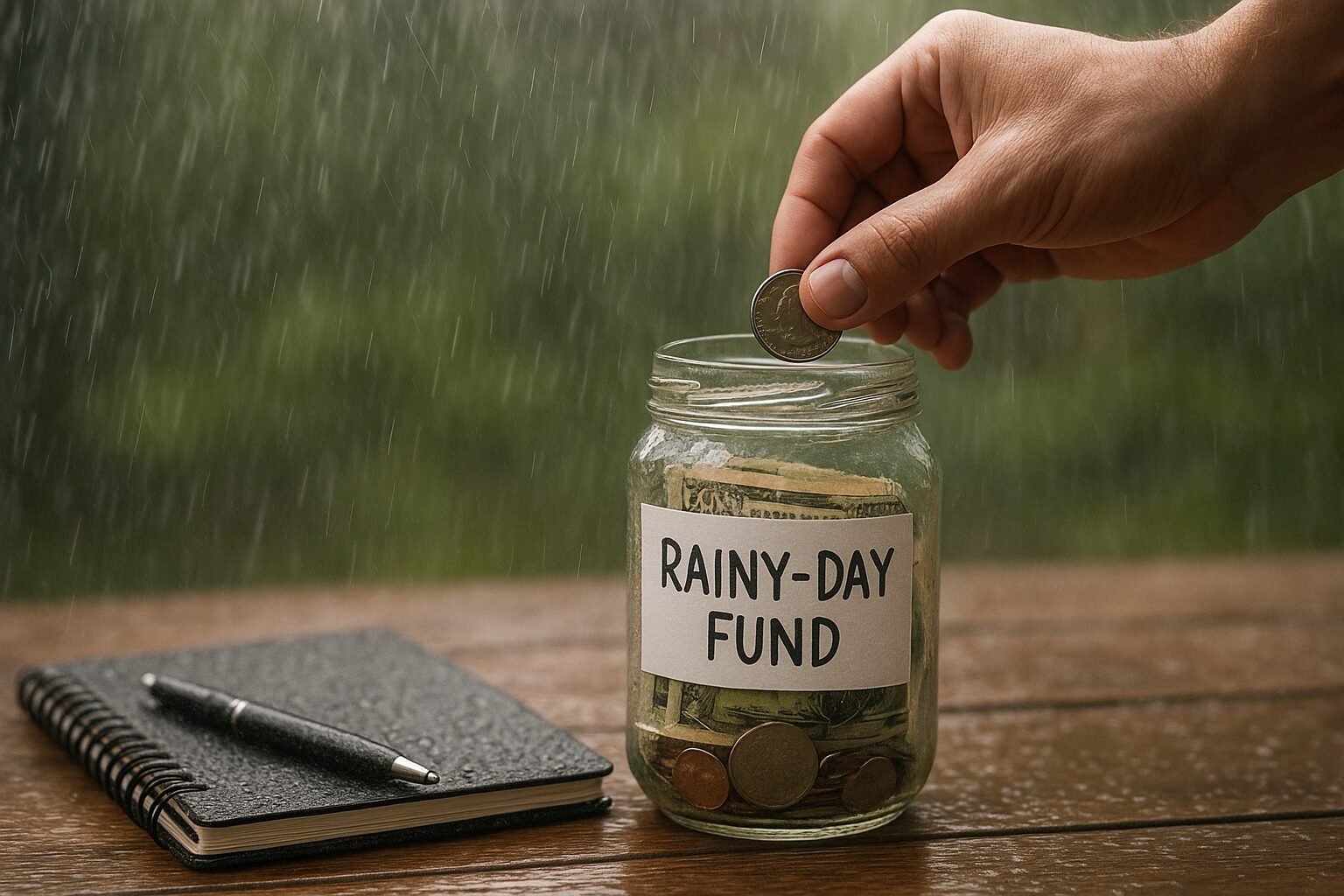A rainy-day fund is a dedicated savings account set aside for unexpected, non-emergency expenses—like car repairs, appliance replacements, or surprise medical bills. Unlike an emergency fund, which covers major financial crises such as job loss or medical emergencies, a rainy-day fund helps you handle everyday surprises without derailing your budget.
Having a rainy-day fund is crucial for maintaining financial stability and avoiding debt during unforeseen circumstances.
This guide will walk you through building a rainy-day fund step by step—without stress, guilt, or overwhelm.
Assess Your Current Financial Situation
Before you start saving, take a clear look at your finances:
- Review Income and Expenses: List all sources of income and monthly expenses.
- Identify Debts: Note any outstanding debts and their interest rates.
- Determine Savings Potential: Decide how much you can realistically set aside each month.
Understanding your financial situation helps you set achievable savings goals and avoid overcommitting.
Set Clear and Achievable Goals
Start small to build momentum:
- Decide on a Target Amount: Aim for $500 to $1,000 as an initial goal.
- Break It Down: For example, saving $500 in 5 months means setting aside $100 per month.
- Set a Timeline: Choose a realistic timeframe that fits your budget.
Achieving these smaller goals boosts confidence and keeps you motivated.
Choose the Right Savings Account
Select an account that suits your needs:
- High-Yield Savings Accounts: Offer better interest rates than regular savings accounts.
- Separate Accounts: Keep your rainy-day fund separate to reduce temptation to spend.
- Accessibility: Ensure you can access the funds quickly in case of need.
Research different banks and credit unions to find the best options available.
Create a Budget that Supports Saving
Integrate savings into your budget:
- Allocate Funds: Treat your rainy-day fund contribution as a non-negotiable expense.
- Reduce Unnecessary Expenses: Cut back on non-essential spending to free up more for savings.
- Automate Transfers: Set up automatic transfers to your rainy-day fund to ensure consistency.
Budgeting tools and apps can help track your spending and savings progress.
Growing Your Rainy-Day Fund Over Time
1. Start With a Solid Base
- Make sure you have at least 1–2 months of essential expenses saved.
- This base reduces stress and builds confidence in your fund.
2. Use Extra Income Wisely
- Allocate bonuses, tax refunds, or side hustle income directly to your fund.
- Treat these as “boosters” rather than spending money.
3. Gradually Increase Contributions
- Increase savings percentages as your income grows.
- Even a 1–2% increase each year compounds over time.
4. Keep Funds Liquid, but Grow Safely
- Use high-yield savings or money market accounts to earn interest.
- Avoid high-risk investments; the goal is accessibility, not aggressive growth.
5. Set Milestones and Track Progress
- Break your target into achievable steps (e.g., $500, $1,000, $3,000).
- Celebrate milestones to maintain motivation.
6. Review and Adjust Annually
- Reassess your living expenses and emergency needs each year.
- Adjust your savings goal accordingly.
7. Avoid Temptation
- Only use the fund for true emergencies.
- Keep it separate from everyday checking accounts to prevent accidental spending.
Rainy-Day Fund Growth Plan
| Year | Monthly Contribution | Extra Income Added | Total Saved | Notes |
|---|---|---|---|---|
| 1 | $100 | $500 (bonus) | $1,700 | Build base fund (≈1–2 months expenses) |
| 2 | $120 | $300 (tax refund) | $3,140 | Gradually increase contributions |
| 3 | $150 | $400 (side hustle) | $5,040 | Start using high-yield savings account |
| 4 | $180 | $500 (bonus) | $7,560 | Set milestone celebrations |
| 5 | $200 | $600 (side hustle) | $10,560 | Review & adjust goals annually |
Tips for Growth:
- Treat bonuses, refunds, and side hustle income as accelerators, not regular spending money.
- Automate contributions so it’s stress-free and consistent.
- Keep funds in a separate high-yield account to avoid temptation.
- Celebrate milestones to maintain motivation.
Setting a Realistic Rainy-Day Fund Goal
- Assess Expenses: Calculate monthly essentials and include irregular costs like insurance.
- Decide Fund Size: Aim for 3–6 months of essential expenses, adjusted for your situation.
- Save by Percentage: Start with 10–20% of income and increase gradually.
- Set Milestones: Break the goal into smaller amounts to track progress and stay motivated.
- Consider Timeline: Choose a timeline that balances speed with stress-free saving.
- Stay Flexible: Adjust the goal as your financial situation changes and review annually.
- Automate Contributions: Set up automatic transfers to make saving effortless.
Avoiding Common Pitfalls With Your Rainy-Day Fund
- Don’t Spend on Non-Emergencies: Use the fund only for true emergencies like medical bills, car repairs, or job loss.
- Avoid Overextending: Save at a sustainable pace without cutting essential expenses.
- Keep Funds Accessible: Store in a high-yield savings or money market account—not too hard to access.
- Account for Inflation: Choose an account that earns interest to maintain your fund’s value.
- Review Regularly: Adjust your goal as income, expenses, or life circumstances change.
- Separate From Daily Spending: Keep the fund in a dedicated account to prevent accidental withdrawals.
- Automate Contributions: Set up automatic transfers for consistent, stress-free saving.
Increase Your Savings Without Stress
Boost your savings with these strategies:
- Side Gigs: Consider freelance work or part-time jobs to earn extra income.
- Cash-Back Apps: Use apps that offer cash-back on purchases to save more.
- Windfalls: Allocate bonuses, tax refunds, or gifts directly to your rainy-day fund.
Even small, consistent contributions can lead to significant savings over time.
Stay Consistent and Avoid Common Pitfalls
Maintain your savings habit:
- Avoid Unnecessary Withdrawals: Use the fund only for its intended purpose.
- Adjust Contributions as Needed: Increase savings when possible, and decrease if necessary.
- Celebrate Milestones: Acknowledge your progress to stay motivated.
Remember, consistency is key to building and maintaining your rainy-day fund.
Conclusion
Building a rainy-day fund is a practical step toward financial security. By assessing your finances, setting achievable goals, choosing the right savings account, budgeting effectively, and staying consistent, you can create a safety net that provides peace of mind during unexpected situations.
Start small, stay consistent, and watch your rainy-day fund grow.
Frequently Asked Questions
1. What is the difference between a rainy-day fund and an emergency fund?
A rainy-day fund covers minor unexpected expenses, while an emergency fund is for major financial crises like job loss or medical emergencies.
2. How much should I save in my rainy-day fund?
Aim for $500 to $1,000 as an initial goal. Adjust based on your personal circumstances.
3. Can I use my rainy-day fund for anything?
Use it only for unexpected, non-emergency expenses to maintain its purpose.
4. How can I make saving easier?
Automate transfers to your rainy-day fund and reduce unnecessary expenses to make saving more manageable.
5. What if I can’t save much each month?
Start with small amounts. Consistency is more important than the amount saved.
Disclaimer
The information provided in this article is for general informational purposes only and does not constitute financial advice. Always consult with a qualified financial advisor before making any financial decisions.



